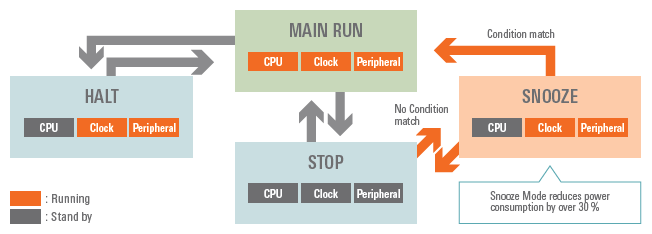Are you in the market for a microcontroller (MCU) but aren’t sure which one to choose? For most designers, it can be tempting to choose the biggest, most powerful 32-bit or 64-bit MCU available. Offering a combination of high-performance CPU cores, a variety of accelerators, and peripheral functions, these devices are definitely attractive. The question is: Do you really need all that computing muscle or is it overkill for your specific design?
32-bit MCUs may sound great at first, but the truth is that they aren’t always your best option. In many cases, less powerful, lower-bit-count MCUs are a better fit for the job.
That’s why 16-bit MCUs are still among the most popular and useful solutions on the market. In fact, out of the more than 3.5 billion MCUs that Renesas ships yearly—which makes us the number one 16- and 32-bit MCU supplier worldwide—16-bit devices are embedded in millions of applications, spanning automotive, biomedical, consumer, industrial, and IoT. And because every application has different requirements, Renesas offers the industry’s most comprehensive lineup of 16-bit products, giving our customers the ability to select the best possible solutions for their designs.
So, what do you need to know about 16-bit MCUs and why are so many designers turning to them?
Advantages of 16-Bit MCUs
When it comes to choosing an MCU for your project, more powerful isn't always better. Instead, it's better to start by understanding the requirements of your application. Ask yourself, "How can I choose the MCU that's most optimized for my design while minimizing overhead, unneeded system complexity, and cost?"

The RL78 family of MCUs offers high performance, low power consumption, and reliable safety functions.
You might find that your answer is a 16-bit MCU. Let's take a look at some of their advantages.
- Lower bit count = less complexity: With a simplified architecture, 16-bit MCUs are considerably cheaper to produce, simpler with which to design, and easier to program. These benefits translate to faster time to market and lower overall bill of materials (BOM) costs for the device.
For a small home appliance like a coffee maker, or a portable consumer-electronic product like smart earbuds, every cent counts for the consumer. In cases where lower BOM cost translates directly to lower prices on the shelf, good design choices give manufacturers a competitive edge in the marketplace.
- Low power: By the same token, the no-frills architecture of 16-bit MCUs makes them inherently more power-efficient. With less overhead, a smaller instruction set, and fewer registers, 16-bit MCUs consume less power overall than a comparable 32-bit device.
Consider a smartwatch. If a 16-bit MCU meets the application's performance requirements, the smartwatch will run significantly longer without needing a battery recharge. Since battery life is a key metric in every smartwatch, it's an important differentiating feature for consumers.
In some classes of medical devices, such as continuous glucose monitors (CGMs) worn by people with diabetes, or personal electrocardiogram (EKG) monitors that detect heart irregularities, running out of battery power could prove dangerous, even life-threatening. This makes a 16-bit MCU not just attractive to the overall design but potentially vital to human health.
- Small footprint: 16-bit MCUs are also physically smaller than their 32-bit counterparts. When you're designing space-constrained devices, every square mm matters.
Take the example of an augmented reality (AR) or virtual reality (VR) headset. These highly portable devices require designers to pack a ton of functionality—including optics, battery, processing, and sensors—into a small footprint. And since consumers wear the headset on their faces, the designer has to keep it light. 16-bit MCUs deliver a small footprint and lightweight design without sacrificing functionality.
RL78: The Industry's Best-Selling 16-Bit MCU
Recognizing the importance of 16-bit MCUs in the greater MCU ecosystem, Renesas has expanded our portfolio of 16-bit MCUs.
The RL78 is a family of truly low-power 8- and 16-bit MCUs that offer numerous competitive advantages in the marketplace. Power efficiency is at the top of the list. Renesas' newest RL78 offering, for example, the RL78/G22 features the industry's lowest current consumption levels of 37.5µA/MHz during CPU operation and 200nA during STOP mode. As a testament to its place in the competitive landscape, it currently holds the world’s highest score in the ULPMark-PP (Ultra-Low Power) benchmark.

The RL78 family of MCUs offers three low-power modes that maximize battery life by disabling idle CPU features.
Another benefit of Renesas' RL78 family products is that they are tiny. The RL78/G11, RL78/G13, and RL78/G1A products, for example, come in 3mm x 3mm packages—as small as a grain of rice. Importantly, this miniaturization is achieved without sacrificing functionality, as these devices still integrate a wide range of features, such as analog-to-digital converters (ADCs), timers, capacitive touch, LCD drivers, on-chip memories, and more.
The RL78 family is extremely versatile. With dozens of different options, designers can use the RL78 family in a variety of applications—from motor control and consumer electronics to industrial controls. With so many flavors of the RL78, designers can always find a solution that fits the requirements of their unique application.
Renesas Is Leading the Way
There's no doubt that despite the growing popularity of larger bit-count MCUs, 16-bit MCUs are alive and well today. Offering an unbeatable combination of cost-efficiency, low power, and space savings, 16-bit MCUs are still the best choice for many applications.
Would you like to harness the advantages of 16-bit MCUs and learn why the RL78 family is the industry's best-seller? Visit RL78 Low Power 8- and 16-bit MCUs for more information on the RL78 product family today.

